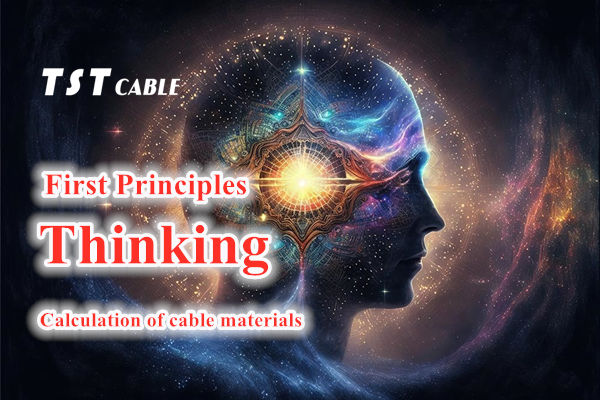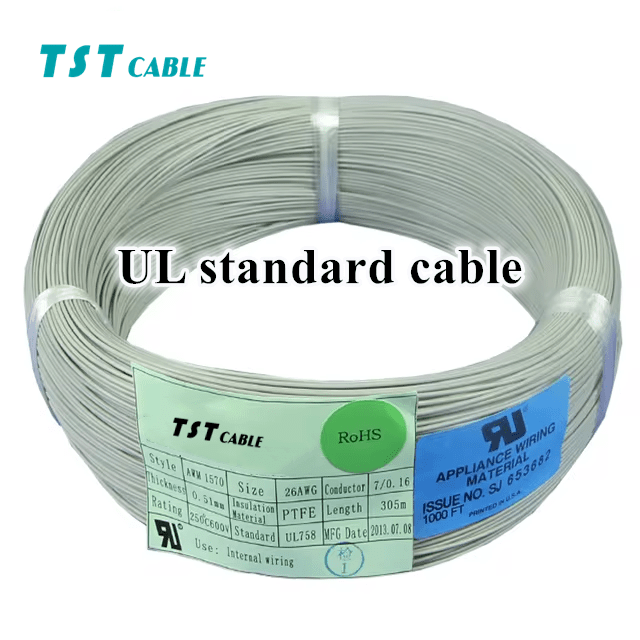Do you know what thinking methods are used by the world’s top technical engineers to study and calculate cable materials? TST cables will reveal the answer to you immediately.

First principles calculation is a theoretical calculation method that predicts the properties of materials based on the principles of quantum mechanics. This method does not rely on any empirical parameters, but starts from the basic laws of physics and calculates the electronic structure and other properties of materials by solving the Schrödinger equation. In the study of cable materials, first principles calculation can be used to predict and optimize the performance of cable materials, including conductivity, thermal stability, mechanical strength and other aspects.
First principles detailed explanation
First principles (First Principles Thinking) is a way of thinking and solving problems that encourages people to start from the most basic facts and gradually build an understanding of complex problems. This method emphasizes returning to the basic principles or facts of things, rather than relying solely on existing assumptions, experience or traditional practices. Through this method, people can break through the limitations of conventional thinking and find innovative solutions.
Definition of first principles
First principles is a logical reasoning method that advocates breaking down complex problems into their most basic components and then reconstructing the understanding of the problem from these basic principles. The core of this approach is to think about the problem “from scratch” instead of building on existing assumptions.
Steps to apply the first principle
Identify basic facts: determine the basic components of the problem, that is, those facts that do not require further explanation or proof.
Derive principles: Based on these basic facts, derive a series of principles or conclusions.
Reconstruct the model: Use these principles to reconstruct the understanding or solution of the problem.
Verify the results: Test the effectiveness and feasibility of the new model.
Advantages of the first principle
Innovation: Encourage thinking outside the box and help discover new solutions.
In-depth understanding: By deeply understanding the essence of the problem, you can grasp the problem more comprehensively.
Simplify complexity: Break down complex problems into basic units to make them more manageable.
Critical thinking: Cultivate the habit of questioning existing assumptions and promote the development of critical thinking.
First principle case
Case: Tesla electric car
Elon Musk adopted the first principle thinking method when he founded Tesla. Instead of considering the traditional cost of automobile manufacturing, he started from the basic components of the battery (metals such as lithium, cobalt, and nickel) and thought about how to reduce costs. In this way, Tesla was able to launch affordable electric cars and revolutionize the automotive industry.
Difference between first principles and traditional thinking
Traditional thinking often relies on existing knowledge and experience, and is prone to fall into the trap of “this is how we have always done it”.
First principles encourage thinking about problems from the beginning, breaking the routine, and looking for fundamental solutions.
Basic principles of first principles calculations
First principles calculations are usually based on density functional theory (DFT), a quantum mechanical method used to study the electronic structure of multi-electron systems. The core of DFT is the Cohen-Shen Lujiu theorem, which states that the ground state properties of a system can be described by electron density rather than wave functions. By calculating the electron density, the energy and many other physical properties of the system can be obtained.
How to apply first principles
Ask: Keep asking “why” until you get to the most basic facts.
Analyze: Analyze these basic facts and find out the connections between them.
Refactor: Build new models or solutions based on these basic principles.
Iterate: Continuously test and improve these new ideas.
Application in cable materials
Selection and optimization of conductor materials
Conductivity: By calculating the electronic structure of the material, the conductivity of the material can be predicted. For cable conductors (such as copper or aluminum), first-principles calculations can help evaluate the effects of different alloy compositions on conductivity.
Interface effect: Study the electronic structure of the interface between the conductor and the insulation layer to optimize the contact resistance and improve the overall performance.
Selection and optimization of insulating materials
Dielectric constant: By calculating the dielectric constant of the insulating material, the dielectric properties of the material can be predicted, which is crucial for designing cables with low losses.
Thermal stability: Study the stability of the material at high temperatures to ensure that the cable still maintains good insulation performance in high temperature environments.
Selection and optimization of shielding materials
Shielding effect: By calculating the electronic structure of the material, the shielding performance of the material can be predicted, which is very important for improving the anti-interference ability of the cable.
Mechanical properties: Study the hardness and toughness of the material to ensure that the cable is not easily damaged during installation and use.
Selection and optimization of sheath materials
Weather resistance: By calculating the chemical stability of the material, the durability of the material under different environmental conditions can be predicted.
Mechanical properties: Evaluate the wear resistance and tensile strength of the material to ensure that the cable is not damaged during use.
Computational tools and software
VASP (Vienna Ab initio Simulation Package): widely used for first-principles calculations in solid physics and materials science.
Quantum ESPRESSO: open source first-principles calculation package suitable for electronic structure calculations.
Gaussian: quantum chemical calculations for molecular systems, which can also be extended to calculations for solid materials.
Materials Studio: a comprehensive set of material modeling and simulation software, including a variety of calculation methods.
Case studies
Conductor materials: use first-principles calculations to study defect formation energy and diffusion mechanisms in copper alloys to optimize alloy composition and improve conductivity and mechanical properties.
Insulating materials: study the dielectric properties of materials such as polyvinyl chloride (PVC) and cross-linked polyethylene (XLPE) to improve the insulation layer of cables.
Shielding materials: analyze the electromagnetic shielding effect of copper braided shielding to improve the anti-interference ability of cables.
First principles is a powerful theoretical tool that can help TST CABLES cable manufacturer technical researchers gain a deep understanding of the relationship between the microstructure of cable materials and their macroscopic properties, avoiding being bound by existing frameworks and prejudices.
Through these calculations, material selection and processing can be optimized at the design stage, thereby improving the overall performance of the cable. Through this method, we can understand the nature of problems more deeply, discover innovative solutions, and promote scientific and technological progress and social development. With the continuous advancement of computing resources, the application of first-principles calculations in TST CABLES cable material science will become more extensive and in-depth.
As a theoretical tool, first-principles calculations play an important role in the design and optimization of cable materials. Through these calculations, the physical and chemical properties of materials can be predicted, helping researchers understand the relationship between the microstructure and macroscopic performance of materials. This method can not only accelerate the research and development process of new materials, but also provide a theoretical basis for the selection of cable materials, and ultimately improve the performance and reliability of cable products. Through this method, we can understand the nature of things and problems more deeply, discover innovative solutions, and promote global scientific and technological progress and social development. With the continuous advancement of computing resources, the application of first-principles calculations in TST CABLES cable material science will become more extensive and in-depth.
If you need further cable technical support or customized cable solutions, you can visit the TST CABLES official website
or feel free to send an email to the professional cable engineer of TST cable manufacturer (email: lixiangchao@testeck.com, please state your country, your industry, and your needs in the email).
Also available in:
English



